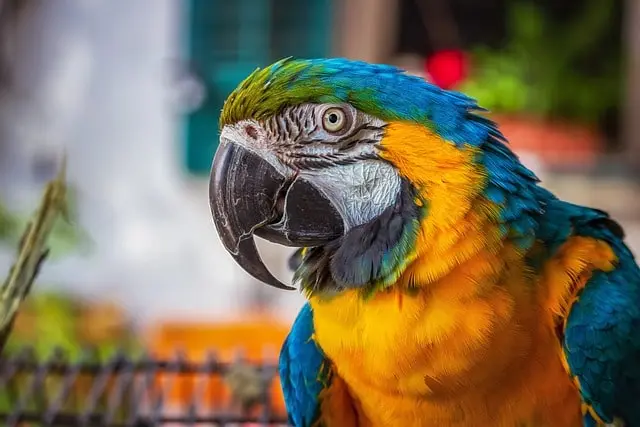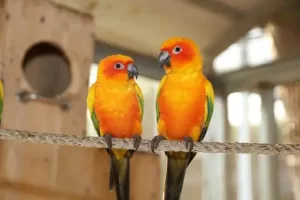Parrots exhibit many funny quirks, but none are as adorable as the head bob. You may have seen your parrot bounce its head up and down like it is in a rock concert head-banging for the first time. And in a way, that is what it is doing.
Parrots bob their heads on multiple occasions and depending on when they do it, it can have several meanings. Most commonly parrots bob their heads out of excitement, dancing to music, or when they want attention.
Baby parrots typically bob their heads when they’re hungry, however, this behavior sometimes also continues into adulthood.
Sometimes, a parrot preparing to regurgitate can also appear to be doing the head bob. When a parrot is about to regurgitate, it bobs its head in an up-and-down motion and stretches its neck to bring partially digested food from the crop back into its mouth. This is normal behavior if the parrot does not do it very often.
Quick Navigation
Why Do Parrots Bob Their Heads Up And Down?
When a parrot bobs its head, it usually has a positive meaning. But like many other parrot behaviors, the explanation can differ based on what other body language signs the bird shows. Below are the meanings of head bobbing in parrots:
They’re Excited
Parrots are most excited when they know they’re about to get some playtime with their owners. When you talk to your parrot or play with them, it may start bobbing it is because it is excited. This may especially be the case if you have been away for a while from your parrot.
Head bobbing is a happy behavior in parrots and you will see it most often when they’re in a playful mood. They also raise their head feathers when they are feeling upbeat and entertain themselves.
Dance Moves
It is no secret that parrots like music. They enjoy listening to music and have some of the most entertaining dance moves. One of the signature moves parrots have is the head bob.
Parrots sway their bodies, tap their foot, and bob their heads grooving to their favorite beats.
When parrots dance they bob their heads in many different ways. There’s the downward head bob, the head bob with feet tapping, the head swinging, and many more.
Snowball, the cockatoo was the first parrot to clearly demonstrate synchronized body movements to music beats. The parrot also has a repertoire of 14 different dance moves. (Via Wikipedia)
Regurgitation Mistaken As Headbobbing
Sometimes, it may seem like your parrot is head bobbing while actually what it is doing is regurgitating its food. Parrots make the head bobbing motion to bring the food from their crop back up to their mouth so they can regurgitate it.
This behavior is a natural part of their reproductive and social instincts. If your parrot regurgitates food on you, it means that it sees you as a mate.
There’s nothing that you need to do about it, but make sure you do not encourage them in any way. Avoid petting your parrot too much or in intimate areas as that may give them the wrong signals.
You also shouldn’t let your parrot regurgitate on toys and perches. Parrots can sometimes develop bonds with objects in their cage which can lead to hormonal behaviour. If you see your parrot regurgitating on a toy in its cage, you should take it away immediately.
Regurgitation is normal in parrots as long as it is infrequent. While bobbing head frequently is not an issue, if it is followed by regurgitation every time, it could be a problem. Parrots regurgitate excessively when they’re trying to clear their crop. It can also be a sign of crop infection.

They’re Hungry
Crying and head bobbing is a behavior commonly exhibited by juvenile parrots. Baby parrots bob their heads and make crying noises when they’re hungry.
It is their way of communicating with their parents and asking for food. As the parrot grows into an adult it may still bob its head but not for the same reason though.
Wants Your Attention
Even though most adult parrots do not always bob their heads for a snack, they can use it for their owner’s attention.
When parrots are young, head bobbing allows them to get what they want from their parents. So when they grow up head bobbing can get them your attention but it may not necessarily be that it is asking for a snack.
If your parrot is bored being by itself in the cage or has not seen you in a while, it may bob its head and move back and forth to get you to notice it.
The parrot may also use vocalizations along with head bobs. It is one way for parrots to tell you that they want to spend time with you.
Courting Behavior
Head bobbing is a form of visual attraction male parrots use to court females. During courtship, parrots showcase their vibrant plumage and distinctive vocalizations.
They also perform the rhythmic movement of the head as a dance to communicate their willingness and interest to mate. If you have introduced another bird to your parrot recently, it could be that it is performing to attract her.
Aggression
Parrots have a few tricks up their sleeves to make them look intimidating. When a parrot feels threatened by someone in its surroundings, it may use head bobbing to show aggression and defend its territory.
An angry parrot may fluff up its feathers to make it appear bigger. It may strut back and forth in its cage while bobbing its head up and down.
If there’s an unwanted guest near your parrot’s cage, you should address the issue so that it does not bother your parrot too much.

Boredom And Stress
It is in a parrot’s nature to socialize and keep themselves busy. But sitting in their cages, they do not always have all that much to do unless they are provided with some form of enrichment.
If you know that you haven’t been giving enough quality time to your parrot lately, head bobbing should be a concerning matter to you, as it may indicate stereotypical behavior.
Parrots that are kept alone and not provided opportunities for social interactions often end up bored and stressed. Staying cooped up in their cages can be mentally taxing for parrots.
According to Science Direct, parrots kept in secluded environments can develop abnormal and repetitive behaviors, also known as stereotypies.
Head bobbing is a normal behavior but it can be considered stereotypical when the parrot head bobs in a repetitive manner.
Stereotypies can manifest in other behaviors such as pacing back and forth, screaming, or beak tapping.
It is a response to a lack of mental stimulation in captive settings. These behaviors indicate that the parrot is trying to cope with the limitations of its environment.
If you notice this with your parrot, it is essential to improve their social enrichment and provide them with opportunities for activities and a stimulating environment to help reduce stress. This can include introducing toys and incorporating regular social interaction.







